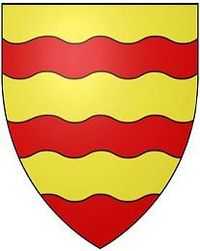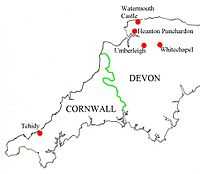Basset family


The Bassets were amongst the early Norman settlers in England. The family survives in the male line today in 2012, making it one of the most ancient of English families. The Cornish branch of the family became very wealthy in the 18th century from leases granted by them for tin and copper mines located on their estates, most notably the tin and copper mines at "Pool", between Camborne and Redruth, from which they earned income of £10,000 per annum. The family also controlled two of the richest mines in Cornwall, namely "Cook's Kitchen", in Pool and "Dolcoath", near Camborne.[1] They were the fourth largest landowner in Cornwall in 1873, as revealed by the Return of Owners of Land, 1873, with 16,969 acres, after the Rashleigh family of Menabilly (30,156 acres), the Boscawens of Tregothnan (25,910 acres) and the Robartes of Lanhydrock (22,234 acres).
Origins
One Thurstan Basset appears in the Battle Abbey Roll, and they have been, from at least the days of the Plantagenets, associated with the manor of Tehidy in the parish of Illogan near Camborne in Cornwall.
According to Hals, a Basset held some military post in Cornwall as early as the time of Robert, Earl of Mortain. However Lysons (who had a good opportunity of forming a sound judgment, from his personal acquaintance in the early part of the 19th century with Sir Francis Basset, 1st Baron de Dunstanville) says that the Bassets (who seem to have been first settled in Oxfordshire and other of the midland counties) can scarcely be said to have become Cornish folk (although they may have held property in Cornwall earlier) until the marriage of Adeliza de Dunstanville with Thomas, Baron Basset of Hedendon, Oxfordshire, in the time of Henry II. Her ancestor, Alan de Dunstanville, was lord of the manor of Tehidy as early as 1100. Mr. G. P. Scrope, M.P., in his 'History of the Manor of Castle Combe, Wilts,' corroborates this account.
This Thomas Basset appears to have been a descendant (probably a greatgrandson) of Henry I's justiciary (Osmund Basset), and himself held a like post under Henry III. Other members of the families of Basset and De Dunstanville also intermarried in the reign of Richard I; and in fact it is extremely difficult to trace the details of the first settlement of the Bassets in Cornwall.
But, once settled in the county, they have steadfastly remained there, at Tehidy, near Camborne, up to the present time, albeit in a junior line; and the bones of many generations of Bassets lie in Illogan church. They intermarried with Trenouth, Trengove, Trelawny, Marrys, Enys, Carveth, Godolphin, Prideaux, Grenville, Pendarves, Rashleigh, and others, many of which families are now extinct, and their blood is thus intermingled with that of most of the prominent Cornish families.
Amongst the early Cornish Bassets may be cited Sir Ralph Basset, who was summoned from Cornwall to attend, with other knights, King Edward I in the Welsh wars at Worcester in 1277, and it was probably he or one of his sons who obtained from Edward III a patent for certain markets and fairs for the neighbouring town of Redruth in Cornwall. He also procured a license to embattle his manor house of Tehidy in the year 1330–31, and Leland mentions it as "a castelet or pile of Bassets". The name of a William Basset appears in the time of King Edward II (1324) amongst the "nomina hominorum ad arma in com. Cornubiæ" ("names of men-at-arms in the county of Cornwall") (Carew), and another Basset of the same name held a military fee at Tehidy and Trevalga in 1403 (3rd Henry IV).
During the reigns of the 6th, 7th, and 8th Henries the Bassets were frequently Sheriffs of Cornwall; and during the reign of King Edward IV, according to William of Worcester, a Sir John Basset held the castle, the ruins of which still stand, on the summit of Carn Brea, not far from Tehidy. Their "right goodly lordship", as John Leland called it, extended over the parishes of Illogan, Redruth, and Camborne, the advowsons of which pertained to the manor of Tehidy, and the livings of which were occasaionally held by some member of the family; but their wealth has in later times been mainly derived from the enormous mineral riches of this part of Cornwall, albeit they likewise had considerable property in the north-eastern part of the county.
The names of the earlier Bassets are little known in history, save that in the time of Henry VII a John Basset, then sheriff of Cornwall, found his posse commitatus too weak to suppress the "Flammock Rebellion".
Senior Devon branch
In 1558 the Bassets divided into two branches, the senior remaining at Umberleigh in Devon having given Tehidy to the junior branch, which remained there until 1915. The senior Devon branch moved to Heanton Punchardon and became extinct in the male line in 1802, but continued under the adopted name of Basset via the female line, in the successive families of Davie and Williams at Watermouth Castle until that adoptive line failed a second time on the death in 1907 without progeny of Walter Basset Basset (1863-1907) (born Walter Basset Williams). The remaining Basset manors in Devon of Umberleigh and Berrynarbor (in which was situated Watermouth Castle) were then sold.
Junior Cornish Branch
The junior Cornish branch continues to this day in 2012, but Tehidy was sold by the family in 1915.[2] The Cornish branch was re-founded by George Basset (d.1589) who in 1558 had been given Tehidy by his nephew Sir Arthur Basset (1541-1586), of Umberleigh, who was buried in the Umberleigh Chapel in Devon but whose chest tomb was moved c. 1820 to Atherington Church where it remains today.
Descent of junior Cornish branch
The descent of the junior branch of the Basset family of Tehidy is as follows:[3]
- George Basset (d.1589), second son of Sir John Bassett (1462-1529), KB, of Umberleigh, was given Tehidy by his nephew Sir Arthur Basset (1541-1586), of Umberleigh. He married Jacquetta Coffin, daughter of George Coffin of Portledge.
- James Basset (son) of Tehidy, in 1587 married Jane Godolphin, daughter of Sir Francis Godolphin, knight and had nine children.
- Sir Francis Basset (d.1645), of Tehidy, (son) a strenuous royalist, sold St Michael's Mount in order to pay fine levied on him by Cromwell during the Commonwealth. Married in 1620 Anne Trelawny, daughter of Sir Jonathan Trelawny, knight.
- John Basset (2nd surviving son), of Tehidy, married Anne Delbridge of Barnstaple.
- Francis Basset (d.1675)(son), married Lucy Hele.
- Francis Basset (1674-1721), (son), of Tehidy, married secondly Mary Pendarves.
- John Pendarves Basset (1713-1739), (eldest son), married Anne Prideaux, daughter and co-heir of Sir Edmund Prideaux, 5th Baronet of Netherton.
- John Prideaux Basset (1740 (posthumous)-1756), (son), died aged 16, when his heir became his uncle, Francis Basset (d.1769)
- Francis Basset (1715-1769), (uncle), of Tehidy, formerly of Imley, Northamptonshire, 2nd son of Francis Basset (d.1721) of Tehidy. MP for Penryn 1766-69. Married in 1756 Margaret St Aubyn (d.1768), daughter of Sir John St Aubyn, 3rd Baronet
- Francis Basset, 1st Baron de Dunstanville and Basset (1757-1835), eldest son. Died without male issue, left one daughter Frances Basset, 2nd Baroness Basset (1781-1855) who died unmarried.
- John Basset (1791-1843) (nephew), son of Rev. John Basset, 2nd son of Francis Basset (d.1769) by his wife Mary Wingfield, daughter of George Wingfield of Durham. MP for Helston 1840-41. Married Elizabeth Mary Price, daughter of Sir Rose Price, 1st Baronet (1768–1834), of Trengwainton.
- John Francis Basset (1831-1869) (eldest son), married Hon. Emily Prendergrast, daughter of Charles Vereker, 2nd Viscount Gort (1768–1842); died without progeny.
- Arthur Basset (1833-1870), (brother) died unmarried.
- Gustavus Lambart Basset (1834-1888) (brother), married in 1869 Charlotte Mary Elmhirst (d.1898)
- Arthur Francis Basset (b. 1873), (son) married Rebecca Salusbury-Trelawny, daughter of Sir William Lewis Salusbury-Trelawny, 10th Baronet (1844-1917). Sold Tehidy in 1915.
- Ronald Lambart Basset (b. 1898) (son), married in 1931 Lady Elizabeth Legge (b. 1908), daughter of William Legge, 7th Earl of Dartmouth (1881–1958). She was appointed in 1959 an Extra Woman of the Bedchamber to Queen Elizabeth The Queen Mother.
- Bryan Ronald Basset (b. 1932) (son), married in 1960 Lady Carey Elizabeth Coke, daughter of Thomas William Edward Coke, 5th Earl of Leicester (1908–1976).[4]
- David Francis Basset (b. 1961), (son) the present representative of Basset of Tehidy.[5]
Further reading
- Cleveland, Duchess of, The Battle Abbey Roll with some Account of the Norman Lineages, in Three Volumes, Vol.1, London, 1889, Basset, being a reconstruction of the legendary Battle Abbey Roll
- Tangye, Michael, Tehidy and the Bassetts, Redruth, 1984
References
- ↑ Havinden, Michael & Stanes, Robin, Agriculture and Rural Settlement 1500-1800, published in Kain, Roger & Ravenhill, William (Eds.) Historical Atlas of South-West England, Exeter, 1999, pp.281-293, p.293, quoting: Halliday, F.E., A History of Cornwall, London, 1959, p.258
- ↑ Burke's Landed Gentry, 1937
- ↑ Burke's Landed Gentry, 1937
- ↑ Debrett's Peerage, 1968
- ↑ Debrett's Peerage, 1968
![]() This article incorporates text from a publication now in the public domain: "Basset of Cornwall". Dictionary of National Biography. London: Smith, Elder & Co. 1885–1900.
This article incorporates text from a publication now in the public domain: "Basset of Cornwall". Dictionary of National Biography. London: Smith, Elder & Co. 1885–1900.